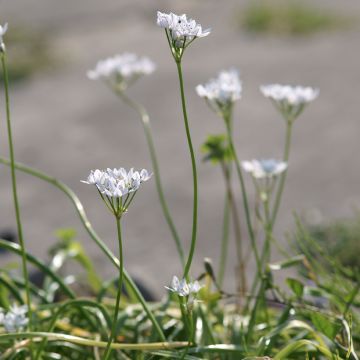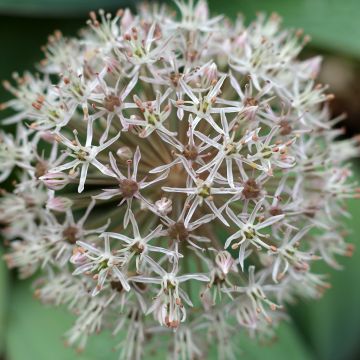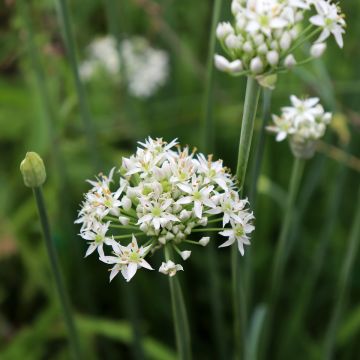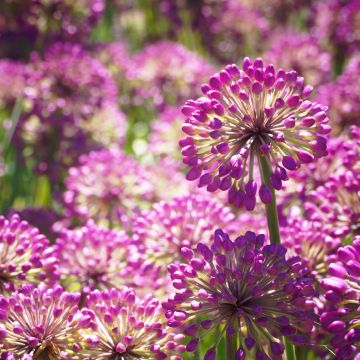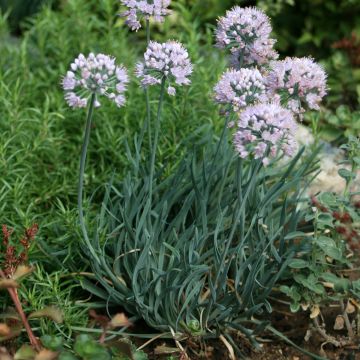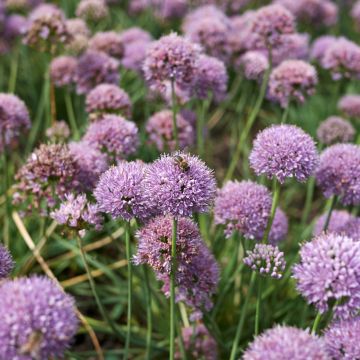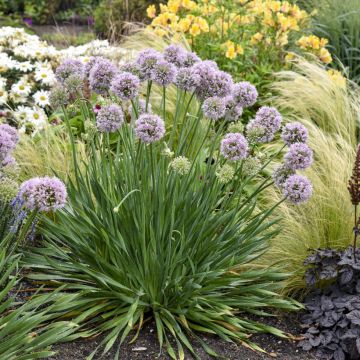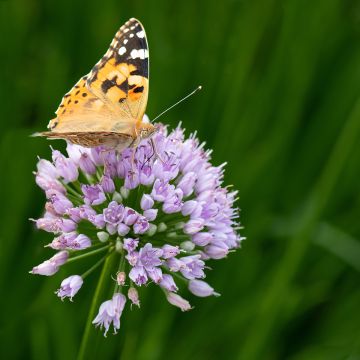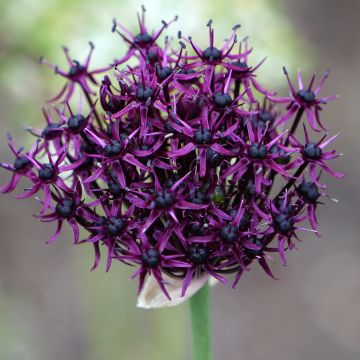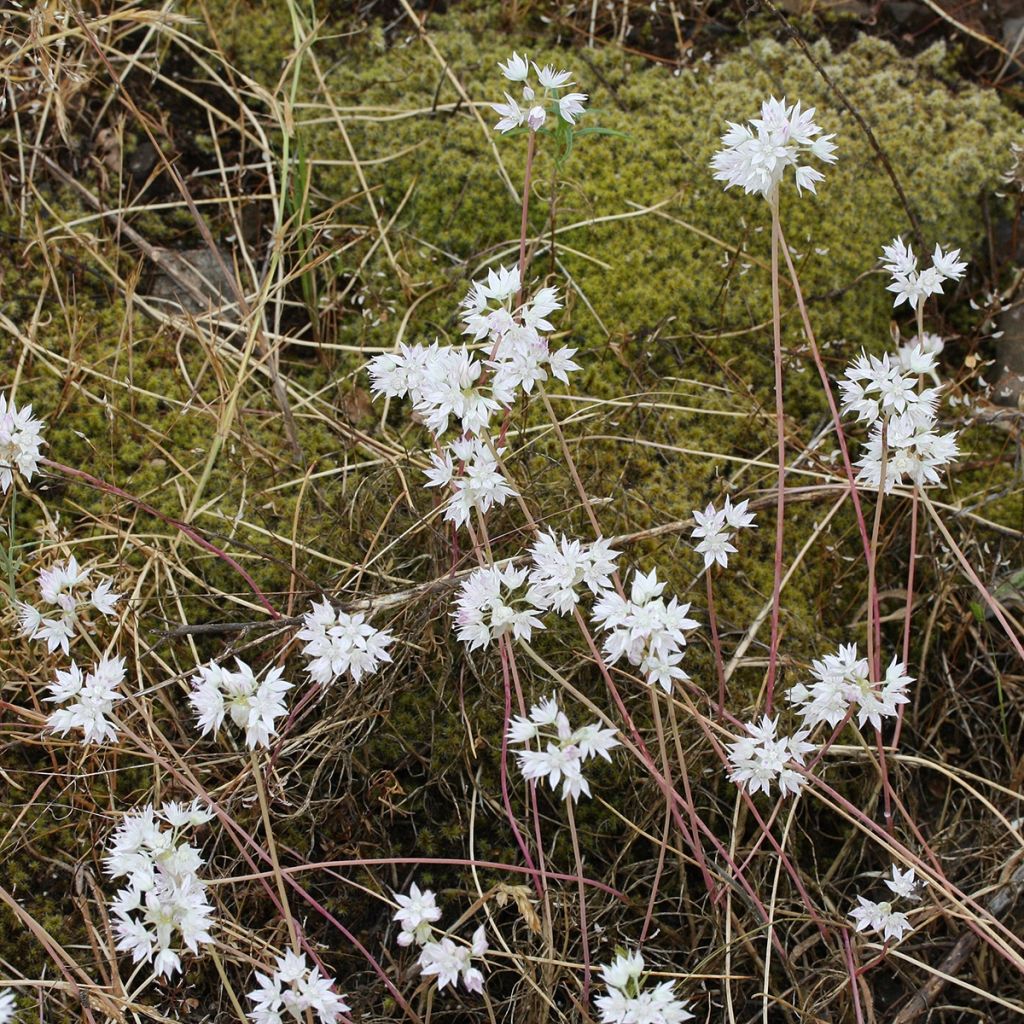

Allium amplectens - Ail d'ornement
Allium amplectens Graceful
Allium amplectens Graceful
Narrowleaf Onion, Ornamental Onion
Why not try an alternative variety in stock?
View all →This plant carries a 6 months recovery warranty
More information
We guarantee the quality of our plants for a full growing cycle, and will replace at our expense any plant that fails to recover under normal climatic and planting conditions.
From €5.90 for pickup delivery and €6.90 for home delivery
Express home delivery from €8.90.
Does this plant fit my garden?
Set up your Plantfit profile →
Description
Allium amplectens 'Graceful' is a truly elegant new variety of ornamental garlic, with its flowering in delicately powdered white umbels with purple-pink stamens. The bulb produces a clump of long, slender, ribbon-like leaves from early spring that wither during flowering, before completely disappearing with the heat and dryness of summer. This small variety is well suited for container or border cultivation.
Allium amplectens 'Graceful', introduced in 2011, is one of the ornamental garlics that are cultivated for their spectacular fresh and dried flowering. Perennial plants with their bulbs, ornamental alliums belong to the Amaryllidaceae family, like garlic, onion, and shallot. The 'Graceful' variety has an upright clump habit of about 15cm (6in) in all directions, consisting of thin, hollow, cylindrical green leaves. Flowering occurs from May to July, depending on the climate. Hollow stems emerge from the foliage clump, bearing spherical inflorescences about 30cm (12in) above the ground, measuring 6cm (2in) in diameter, resembling small pompoms. Each pompom is composed of numerous small pure white star-shaped flowers, punctuated with purple-pink stamens. The floral stems turn reddish towards the end, standing out from the green backgrounds of flower beds. The plant normally goes into dormancy after flowering: the foliage persists in moist soil but disappears in dry soil. It is a perennial plant that should be cultivated for two or three years as, beyond that, it tends to become less productive. It will then need to be divided.
Like many ornamental garlics, Allium 'Graceful' prefers well-drained soils that remain moist during its growth period and adapts well to summer drought, which corresponds to the bulb's dormant period. With its low height, it can be planted in flower bed borders and sunny rock gardens, as well as in a planter or pot on a patio or balcony. Its sculptural appearance brings a lot of personality to the garden. Use this charming ornamental garlic as a focal point in a contemporary or rustic flower bed, especially in a dry garden. Plant it in large groups of at least 10 to 15 bulbs to express its full potential. For example, pair it with 'Black Hero' tulips, pink valerians, or purple scabious (Scabiosa atropurpurea). Plant it alongside purple and white flowers, such as wallflowers, columbines, and knotweeds.
Allium pairs well with roses and chamomile in flower beds, or carrots and beets in the vegetable garden. It can repel aphids and other harmful insects. However, it seems to inhibit the growth of legumes. This plant is a poor companion for alfalfa and sainfoin, for example. Like its relatives, allium is a medicinal plant.
A gardening tip: to limit watering, we recommend mulching the soil with successive thin layers of grass clippings, preferably mixed with dead leaves, starting from late May. This protection keeps the soil moist and reduces weed growth.
Report an error about the product description
Allium amplectens Graceful in pictures


Plant habit
Flowering
Foliage
Botanical data
Allium
amplectens
Graceful
Alliaceae - Liliaceae
Narrowleaf Onion, Ornamental Onion
Cultivar or hybrid
Other Allium
Planting and care
Alliums are easy-to-grow in light soils that do not retain excessive moisture, which causes them to rot. Plant them preferably before the end of October so that they have time to establish themselves well. They fear humidity and waterlogged soils in winter or summer. Give them a sunny spot in well-drained soils, even rocky and chalky or sandy ones. Plant them 10cm (4in) deep, spaced 10cm (4in) apart. They are undemanding but do prefer poor soils. The foliage should not be cut before it turns completely yellow, to allow the bulbs to replenish their reserves. Once acclimatised and established, this allium is quite resistant to drought. If the conditions are met, this bulbous plant requires no special maintenance, but does not like the root competition from other perennials. Alliums are robust plants and are not very prone to diseases if the conditions are met. They multiply slowly by producing bulbils, eventually forming beautiful clumps.
Planting period
Intended location
Care
This item has not been reviewed yet - be the first to leave a review about it.
Haven't found what you were looking for?
Hardiness is the lowest winter temperature a plant can endure without suffering serious damage or even dying. However, hardiness is affected by location (a sheltered area, such as a patio), protection (winter cover) and soil type (hardiness is improved by well-drained soil).

Photo Sharing Terms & Conditions
In order to encourage gardeners to interact and share their experiences, Promesse de fleurs offers various media enabling content to be uploaded onto its Site - in particular via the ‘Photo sharing’ module.
The User agrees to refrain from:
- Posting any content that is illegal, prejudicial, insulting, racist, inciteful to hatred, revisionist, contrary to public decency, that infringes on privacy or on the privacy rights of third parties, in particular the publicity rights of persons and goods, intellectual property rights, or the right to privacy.
- Submitting content on behalf of a third party;
- Impersonate the identity of a third party and/or publish any personal information about a third party;
In general, the User undertakes to refrain from any unethical behaviour.
All Content (in particular text, comments, files, images, photos, videos, creative works, etc.), which may be subject to property or intellectual property rights, image or other private rights, shall remain the property of the User, subject to the limited rights granted by the terms of the licence granted by Promesse de fleurs as stated below. Users are at liberty to publish or not to publish such Content on the Site, notably via the ‘Photo Sharing’ facility, and accept that this Content shall be made public and freely accessible, notably on the Internet.
Users further acknowledge, undertake to have ,and guarantee that they hold all necessary rights and permissions to publish such material on the Site, in particular with regard to the legislation in force pertaining to any privacy, property, intellectual property, image, or contractual rights, or rights of any other nature. By publishing such Content on the Site, Users acknowledge accepting full liability as publishers of the Content within the meaning of the law, and grant Promesse de fleurs, free of charge, an inclusive, worldwide licence for the said Content for the entire duration of its publication, including all reproduction, representation, up/downloading, displaying, performing, transmission, and storage rights.
Users also grant permission for their name to be linked to the Content and accept that this link may not always be made available.
By engaging in posting material, Users consent to their Content becoming automatically accessible on the Internet, in particular on other sites and/or blogs and/or web pages of the Promesse de fleurs site, including in particular social pages and the Promesse de fleurs catalogue.
Users may secure the removal of entrusted content free of charge by issuing a simple request via our contact form.
The flowering period indicated on our website applies to countries and regions located in USDA zone 8 (France, the United Kingdom, Ireland, the Netherlands, etc.)
It will vary according to where you live:
- In zones 9 to 10 (Italy, Spain, Greece, etc.), flowering will occur about 2 to 4 weeks earlier.
- In zones 6 to 7 (Germany, Poland, Slovenia, and lower mountainous regions), flowering will be delayed by 2 to 3 weeks.
- In zone 5 (Central Europe, Scandinavia), blooming will be delayed by 3 to 5 weeks.
In temperate climates, pruning of spring-flowering shrubs (forsythia, spireas, etc.) should be done just after flowering.
Pruning of summer-flowering shrubs (Indian Lilac, Perovskia, etc.) can be done in winter or spring.
In cold regions as well as with frost-sensitive plants, avoid pruning too early when severe frosts may still occur.
The planting period indicated on our website applies to countries and regions located in USDA zone 8 (France, United Kingdom, Ireland, Netherlands).
It will vary according to where you live:
- In Mediterranean zones (Marseille, Madrid, Milan, etc.), autumn and winter are the best planting periods.
- In continental zones (Strasbourg, Munich, Vienna, etc.), delay planting by 2 to 3 weeks in spring and bring it forward by 2 to 4 weeks in autumn.
- In mountainous regions (the Alps, Pyrenees, Carpathians, etc.), it is best to plant in late spring (May-June) or late summer (August-September).
The harvesting period indicated on our website applies to countries and regions in USDA zone 8 (France, England, Ireland, the Netherlands).
In colder areas (Scandinavia, Poland, Austria...) fruit and vegetable harvests are likely to be delayed by 3-4 weeks.
In warmer areas (Italy, Spain, Greece, etc.), harvesting will probably take place earlier, depending on weather conditions.
The sowing periods indicated on our website apply to countries and regions within USDA Zone 8 (France, UK, Ireland, Netherlands).
In colder areas (Scandinavia, Poland, Austria...), delay any outdoor sowing by 3-4 weeks, or sow under glass.
In warmer climes (Italy, Spain, Greece, etc.), bring outdoor sowing forward by a few weeks.

































